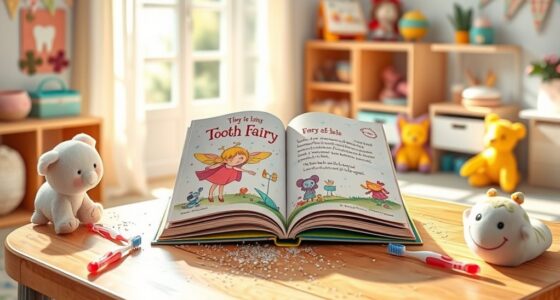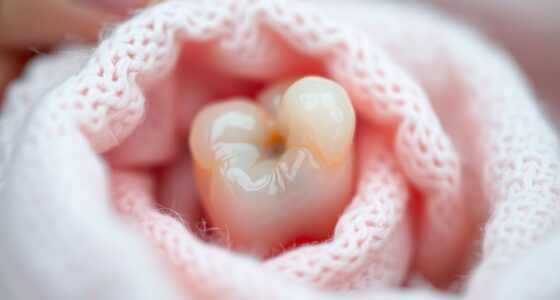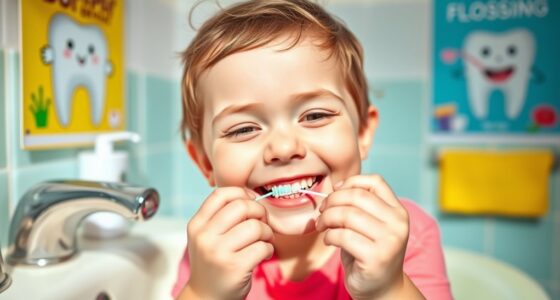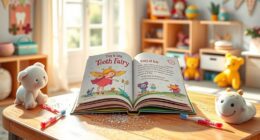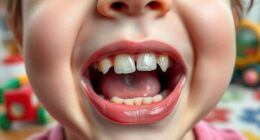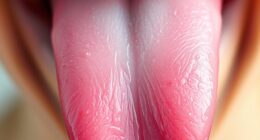Choosing the right toothbrush for your child involves selecting a size that comfortably fits their age and mouth, and a handle that offers easy grip for developing motor skills. Soft bristles are best to gently clean teeth without irritating gums, while fun, colorful designs can motivate your child to brush regularly. As they grow, shifting to a standard adult toothbrush ensures continued effectiveness. Keep examining their progress, and you’ll discover how to make oral care both safe and enjoyable.
Key Takeaways
- Select a toothbrush with soft bristles to protect delicate gums and effectively remove plaque.
- Choose a small head size suitable for your child’s age to ensure comfortable and thorough cleaning.
- Ensure the handle is ergonomic, textured, and easy to grip to promote proper brushing technique.
- Use age-appropriate toothbrushes with fun designs or characters to motivate your child to brush regularly.
- Transition to a standard-sized toothbrush around age 9-10 when your child demonstrates proper technique and motor skills.
Understanding the Importance of Soft Bristles

Understanding the importance of soft bristles is key to protecting your child’s delicate gums and teeth. Soft bristles are gentle on children’s gums, helping prevent irritation and bleeding. They also effectively remove plaque, which supports good oral health without damaging sensitive tissues. AI detection methods have been developed to ensure that digital tools used in dental health are authentic and reliable, enhancing trust in dental technology. The American Dental Association recommends soft-bristled toothbrushes because they reduce the risk of enamel erosion and gum recession. Using medium or hard bristles can harm young teeth and gums, leading to long-term issues. Soft bristles are designed to clean thoroughly while being gentle enough to avoid causing discomfort or injury. Choosing a toothbrush with soft bristles ensures your child’s developing mouth stays healthy and protected, setting a strong foundation for lifelong oral hygiene. Proper dental care practices are essential to maintain this health over time.
Selecting the Proper Size for Your Child’s Age

Choosing the right toothbrush size depends on your child’s age and mouth size. Small heads, about half an inch wide, are best for babies and toddlers. Slightly larger ones suit older kids. Always check the packaging for age recommendations to guarantee a comfortable and effective brush. Additionally, selecting a toothbrush with the appropriate Glycolic Acid concentration can help maintain oral health by gently exfoliating and preventing buildup around the gums.
Age-Appropriate Size Guidelines
Selecting the right toothbrush size for your child depends on their age and mouth development. For babies and toddlers, choose a small toothbrush with a toothbrush head roughly the size of a rice grain or a small fingertip, ensuring it fits comfortably in their tiny mouths.
Children aged 3 to 6 need a toothbrush with a head about half an inch wide to reach all areas effectively and promote good oral hygiene.
As your child grows into the 7 to 10 age range, they can use toothbrushes with slightly larger heads, around one inch long, matching their increasing mouth size.
When they reach adolescence, they can switch to a standard-sized adult toothbrush, typically about one-half to one-inch wide.
Properly sized toothbrushes support thorough cleaning and healthy habits at each stage.
Small Heads for Young Kids
A small toothbrush head is essential for young children to clean their teeth effectively and comfortably. It allows your child to reach all areas of their mouth with ease, promoting good children’s oral hygiene. Look for age-specific toothbrushes with small toothbrush heads designed to fit your child’s mouth size. Incorporating child-friendly design features can make brushing a more enjoyable experience for your little one. These smaller heads help prevent gagging and give your child better control during brushing. Choose toothbrushes with soft bristles to protect delicate gums while still providing thorough cleaning. Additionally, selecting appropriate toothbrush size is crucial for developing proper brushing techniques early on. As advancements in child dental care continue, selecting the right toothbrush can contribute significantly to establishing lifelong healthy habits. Being aware of support hours and availability of resources can help ensure you get guidance when needed, making the process easier for both parent and child. Moreover, considering AI-powered features in some modern toothbrushes can enhance brushing effectiveness by providing real-time feedback and encouragement.
Transition to Larger Sizes
As children grow, their mouths become larger, and their toothbrushes should match this development. Around age 7 or 8, it’s time to shift to a slightly larger toothbrush size that better fits their expanding mouth.
A mature toothbrush with a head about half an inch wide and one inch tall offers better access to all areas, especially the back teeth. The American Dental Association recommends choosing a toothbrush size that comfortably fits in your child’s mouth, making brushing easier and more effective.
Properly sized toothbrushes encourage thorough cleaning and help develop good brushing habits early on. As their growing teeth require more coverage, switching to a larger toothbrush ensures your child can clean effectively while maintaining comfort and promoting healthy oral care routines. Regular audit processes in toothbrush selection can help monitor and improve your child’s oral hygiene practices over time.
Comparing Manual and Powered Toothbrushes

Have you ever wondered whether a manual or powered toothbrush works better for your child? Both can effectively clean teeth if used correctly with fluoridated toothpaste.
Powered toothbrushes often include features like timers and pressure sensors, which can boost brushing effectiveness and support children’s oral hygiene. These features can also help children develop good brushing habits from a young age. Additionally, some models come with fun designs or characters that can encourage kids to brush more consistently, making brushing routines more enjoyable. The choice between manual and powered toothbrushes can also depend on oral health education and how well children are taught to use their toothbrushes properly. Proper guidance on toothbrush maintenance can further improve overall oral health and hygiene outcomes.
Manual toothbrushes are usually more affordable and don’t require batteries or charging, making them convenient for everyday use. They also allow children to learn controlled brushing techniques at their own pace.
For children who struggle with thorough brushing or need motivation, a powered toothbrush might be the better choice. Using an appropriately chosen toothbrush can enhance the overall quality of your child’s oral care routine.
Remember, regardless of type, replacing the toothbrush every three to four months is essential for maintaining ideal oral health. Regular replacement supports effective cleaning and prevents bacteria buildup.
Additionally, understanding the importance of proper brushing techniques and how to use each type effectively can help maximize your child’s oral care routine. Incorporating energetic alignment into your child’s routine, such as making brushing a fun activity, can also encourage better habits.
Ultimately, choosing the right toothbrush depends on your child’s preferences and needs, but both options can contribute to healthy teeth and gums.
Choosing the Right Handle Design and Grip

Ever wonder how the handle design affects your child’s brushing? A handle with a non-slip grip and a thicker design makes it easier for your child to hold and control the toothbrush. An ergonomic handle, often angled or with a flexible neck, helps kids reach all areas of their mouth comfortably and effectively. Brightly colored or character-themed handles can motivate children to brush more regularly and enjoy the process. Larger handles with textured surfaces provide better brushing control, especially as children develop their fine motor skills. Choosing a handle with a comfortable, secure grip encourages proper brushing technique and longer brushing sessions, which are crucial for children’s dental health. Additionally, selecting a handle with a secure grip can prevent slips during brushing, ensuring a safer and more efficient cleaning experience. Using a handle made from child-friendly materials can also reduce the risk of breakage and make cleaning easier for parents. Incorporating ergonomic design principles into handle selection can further enhance comfort and effectiveness for your child’s oral care routine. Moreover, considering age-specific handle sizes can help match the brush to your child’s developmental stage, making brushing easier and more engaging. The right handle design makes brushing easier, more engaging, and more effective for your child’s oral care routine.
Recognizing the Ideal Bristle Type for Gentle Cleaning

Choosing the right bristle type plays a key role in making brushing gentle and effective for your child’s delicate oral tissues. Soft bristles are ideal because they provide gentle cleaning without harming gums or enamel. They effectively remove plaque with minimal risk of gum irritation and enamel erosion, which is especially important for developing teeth. Using essential oils for oral health can also support overall dental hygiene and help prevent issues like cavities and infections. Most children’s toothbrushes feature soft bristles, highlighting their suitability for young mouths.
When selecting a toothbrush, look for:
- Soft bristles for gentle cleaning
- Designed to prevent gum irritation
- Prevents enamel erosion
- Suitable for sensitive oral tissues
- Common in children’s toothbrushes
Picking an Appropriate Toothbrush Head Size

Selecting the right toothbrush head size is essential for effective cleaning and comfort during brushing. A small toothbrush head, about half an inch wide and one inch tall, fits comfortably in your child’s mouth and ensures you can reach all areas, especially the back teeth. Proper size selection helps prevent discomfort and encourages consistent brushing habits. Electric toothbrush heads tend to be smaller than manual ones, making maneuverability easier in small mouths. Choosing the correct size also supports air purifier maintenance by allowing better control and precision, which can make brushing more efficient and enjoyable for your child. Moreover, appropriate toothbrush size can contribute to better overall oral hygiene by ensuring thorough plaque removal and reducing the risk of cavities.
The Benefits of Child-Friendly Design and Personalization

Child-friendly toothbrushes with popular characters or bright colors make brushing more fun and encourage daily use. Personalizing the brush with stickers or paints helps your child feel a sense of ownership and stay motivated. Fun features like glow-in-the-dark handles or themed patterns can turn brushing into an enjoyable routine. Incorporating elements that foster active engagement can further motivate children to develop healthy oral hygiene habits. Utilizing protective styling benefits such as durable and safe materials can also ensure the toothbrush lasts through active use. Additionally, selecting toothbrushes with color accuracy in their design can make the visual experience more appealing and engaging for your child. Emphasizing continuous learning about proper brushing techniques can help instill lifelong good habits. Exploring vetted products ensures that the toothbrushes meet safety and quality standards, providing peace of mind for parents.
Fun Character Options
Kids are naturally drawn to toothbrushes with their favorite characters, making brushing a fun and engaging activity. Character-themed toothbrushes featuring Disney princesses or superheroes boost oral hygiene motivation and turn a routine into play. Fun toothbrush options can include lights, sounds, or vibrant designs that captivate your child’s attention. Child-friendly designs with appealing characters help create positive associations with brushing, encouraging consistency. Personalizing toothbrushes with stickers or custom designs adds a special touch, making your child proud of their oral care tools. These options not only make brushing more enjoyable but also foster lifelong healthy habits. Selecting a toothbrush that promotes proper oral hygiene can enhance your child’s brushing experience and effectiveness. Incorporating child-friendly design elements can significantly improve a child’s enthusiasm for daily brushing, making it a positive part of their routine. Choosing fun character options ensures your child looks forward to brushing time and feels connected to their toothbrush. When selecting a toothbrush, consider design features that support easy handling and effective cleaning, further motivating your child to maintain good oral health.
Customizable Appearance Features
Personalizing a toothbrush with your child’s favorite characters, colors, or designs can substantially boost their enthusiasm for daily brushing. Customizable toothbrushes with a child-friendly design make oral hygiene motivation easier by aligning the tool with their interests.
Adding stickers or non-toxic paints to handle creates a personalized toothbrush that appeals to your kid’s preferences. Bright colors and playful themes help reduce anxiety and make the routine more engaging.
When children see a fun oral care tool that reflects their personality, they’re more likely to take ownership of their habits. These personalized toothbrushes foster a sense of ownership and excitement, encouraging consistent brushing.
Ultimately, a customized appearance makes oral care a positive, fun experience your child will want to maintain.
Increased Brushing Motivation
Have you noticed that children tend to be more enthusiastic to brush when their toothbrush reflects their favorite characters or colors? Customized toothbrushes boost child enthusiasm and make brushing more engaging.
When kids see fun themes or bright colors, they develop positive associations with oral hygiene. Adding stickers or non-toxic paints transforms brushing into a creative activity, increasing brushing motivation.
Personalized dental care helps children feel a sense of ownership over their oral health, fostering independence. Studies show that kids with child-friendly designs are more likely to develop consistent habits.
This approach makes oral hygiene enjoyable and less of a chore, encouraging fun oral hygiene routines that last. Ultimately, a personalized toothbrush can turn brushing from a task into a fun and motivating part of their daily routine.
Knowing When to Transition to an Adult Toothbrush
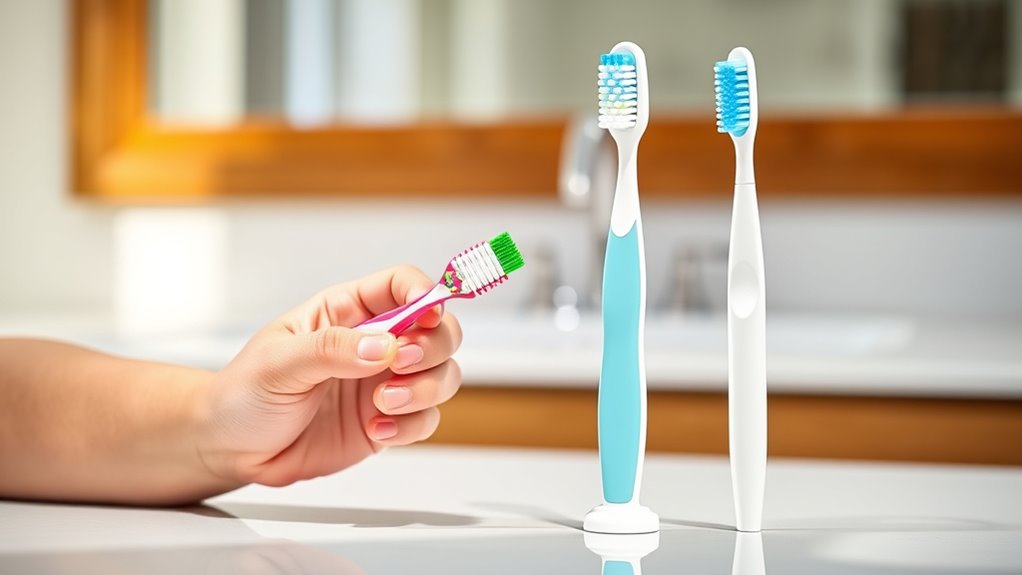
Knowing when to switch your child to an adult toothbrush depends on their ability to brush effectively and handle a standard-sized brush comfortably. Typically, around age 9 or 10, children can manage a regular toothbrush, but it’s essential to assess their child’s ability and comfort. Supervision until about age 7 or 8 helps ensure proper oral hygiene habits. Watch for signs that your child is ready: they can brush thoroughly, use the correct technique, and handle a larger toothbrush without difficulty. Moving too early might compromise their cleaning. Regularly evaluate their proficiency to determine the right changeover age.
| Child’s ability | Transition age | Toothbrush size |
|---|---|---|
| Adequate motor skills | 9-10 years | Standard-sized handle |
| Independent brushing | 7-8 years | Larger brush head |
| Proper technique | 9-10 years | Comfortable grip |
| Consistent oral hygiene | 7-8 years | Suitable for age |
| Comfort with handling | 9-10 years | Proper fit for mouth |
Tips for Ensuring Effective and Consistent Brushing

Ensuring your child brushes effectively and consistently requires some simple strategies. First, set a routine of brushing for at least two minutes twice daily. Use a timer or sing a song to help children stay focused on the recommended duration.
Encourage gentle, circular motions to thoroughly clean all teeth without hurting gums. Regularly replacing the toothbrush every three to four months prevents bacteria buildup and keeps cleaning effective.
Supervise your children’s brushing to ensure they use proper technique and reach all areas of their mouth. Make oral hygiene fun by involving them in choosing their toothbrush.
Consistent guidance and support help develop good habits that protect their teeth and promote healthy oral hygiene routines.
Frequently Asked Questions
How Often Should I Replace My Child’s Toothbrush?
You should replace your child’s toothbrush every three to four months, or sooner if the bristles become frayed or worn. Regular replacement helps prevent bacteria buildup and guarantees effective cleaning.
Keep an eye on the brush’s condition, especially after illnesses, as germs can linger. By changing the toothbrush regularly, you help maintain your child’s oral health and promote good brushing habits.
Are There Specific Toothbrushes for Children With Sensitive Gums?
When shopping for toothbrushes for sensitive gums, you want brushes designed specifically for gentle cleaning.
Look for soft bristles that won’t cause irritation, a small head for easy reach, and a comfortable handle.
These features help protect your child’s delicate gums while effectively cleaning their teeth.
Choosing the right toothbrush isn’t just about size; it’s about prioritizing comfort, safety, and gentle care to keep their smile healthy and happy.
Can My Child Use an Electric Toothbrush From the Start?
You might wonder if your child can start using an electric toothbrush right away. It’s generally okay if they’re old enough to handle it safely and understand gentle brushing.
Start with a small, soft-bristled electric brush, and supervise their use to guarantee they don’t press too hard. Gradually, they’ll get comfortable, making brushing more effective and fun while helping maintain good oral health from an early age.
What Features Make a Toothbrush More Fun for Kids?
To make brushing fun for your kids, look for toothbrushes with colorful designs, characters they love, and bright lights or sounds.
Handles that are easy for small hands to grip also help keep them engaged.
Some toothbrushes have timers or music, making brushing feel like play.
When you choose a playful, interactive toothbrush, your child’s interest in good oral habits naturally grows, making dental care more enjoyable.
How Can I Encourage My Child to Brush Regularly?
They say, “You catch more flies with honey than vinegar,” so to encourage your child to brush regularly, make it fun and positive. Praise their efforts, create a routine, and let them pick their favorite toothbrush or music.
You can also brush together to set an example. Consistency and encouragement turn good habits into a natural part of their day, making brushing less of a chore and more of a family activity.
Conclusion
Choosing the right toothbrush makes a big difference in your child’s dental health. Did you know that children with age-appropriate, soft-bristled brushes are 40% more likely to develop healthy habits? By picking a gentle, comfortable toothbrush tailored to their needs, you set them up for a lifetime of good oral hygiene. Keep encouraging consistent brushing, and watch their smile grow brighter every day!



